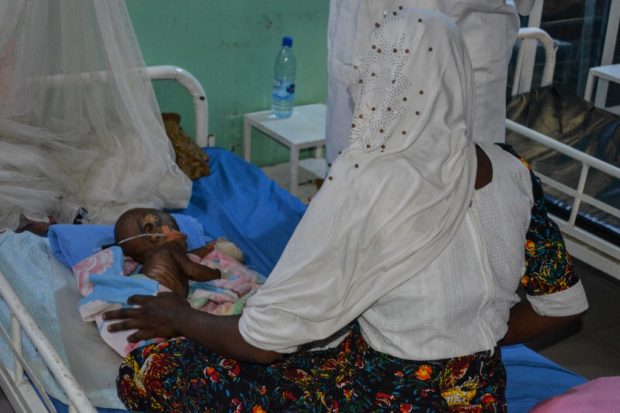
A mother tends to her malnourished child on February 15, 2022 at the pediatric ward of a hospital in Ndjamena. AFP
N’DJAMENA, Chad — Her tiny mouth is constantly open, trying to suck in air.
Adama Assan is four months old, but tips the scales at a pitiful 3.3 kilograms (7.3 pounds) — not even the average weight at birth of a typical newborn in Europe.
“Normally, a baby of her age would weigh six kilos,” said Ousmane Ahmat Mahamat, a supervisor nurse at a ward in a hospital in N’Djamena, the capital of Chad, that specializes in infant malnutrition.
In respiratory distress, the scrawny baby is in intensive care, with a breathing tube inserted through a tiny nostril.
Her 18-year-old mother, Zara Issa, sits by helplessly and watches.
“I’ve been here for four days, watching over her,” Issa says.
In the same unit, run by a Senegal-based NGO called ALIMA, 10-month-old Alkhatir Djimiet is also intubated.
He has matchstick-like arms and ribs that stick out: he weighs only 4.5 kilograms, when it should be seven or eight for a healthy infant of his age.
“He is fighting to survive — he’s in a virtual coma,” said Ahmat Mahamat, putting the child’s file down.
Hunger crisis
These children are among the growing numbers of infants suffering from malnutrition in Chad, a landlocked Sahel country that according to UN figures is the third poorest nation in the world.
In 2021, Chad ranked 113 out of 116 nations on the “Global Hunger Index” — a peer-reviewed tool compiled by European NGOs designed to estimate calorie needs.
Unicef estimates that of Chad’s population of 15 million, around 5.5 million, including 2.7 million children, will need humanitarian assistance this year.
The cause: a security crisis that has forced farming families to leave their fields, overlapping with extreme weather events and the impact of the Covid-19 pandemic.
Those factors are amplified by grinding poverty. Forty-two percent of the population live below the poverty line.
The country ranks third in the world for child mortality, after Nigeria and Somalia, according to the World Bank.
With a death rate of 110 per thousand, more than one child in 10 fails to survive to the age of five.
Wasting away
ALIMA — the Alliance for International Medical Action — works in N’Djamena with a local charity called Alerte Sante (Health Alert).
It reckons that several hundred thousand children in Chad aged between six and 59 months have “severe acute malnutrition”, a medical determination that uses the circumference of the mid-upper arm as a benchmark.
In this phase of malnutrition, the body consumes muscle tissue to provide energy, and the child literally wastes away.
“We are looking after 27 children right now — that’s 10 more than at the same time last year,” said Ahmat Mahamat. “We’re looking at a disastrous situation.”
The unit lacks funds and urgently needs Plumpy’Nut, a French-made peanut-based energy paste provided by international donors that is used to treat severe, acute malnutrition.
No child is ever turned away, though.
In 2019, a surge of admissions meant that staff had at times three children per bed.
So far this year, the unit, located at the Chad-China Friendship Hospital, has admitted 118 children.
They stay for between five and seven days, getting specialist care with intravenous feeding and round-the-clock monitoring.
The survival rate is high — 94 percent — but the figure for treatment in locations outside the capital, while unknown, is likely to be lower.
Can’t afford food
Many of the problems are exemplified by a 25-year-old mother, Haoua Abdoulaye, whose six-month-old son weighs just six kilograms.
“I don’t have enough money to feed him,” says Abdoulaye, a market seller, the floppy doll-like child in her arms.
“I lost my first child because of malnutrition, but I don’t have the means to give him anything other than breast milk.”
Clarisse Bakadah Allaira, a midwife and trained nutritionist, explains that Abdoulaye herself is malnourished and that her breast milk does not provide enough nutrients.
Allaira says the price of staple foods had shot up recently, leaving poor families unable to buy food, or the right kinds of food for good health.
“Last year, a kilo of beans cost 1,000 CFA francs ($1.7, 1.5 euros) — today, it’s 1,500 francs, and the same thing has happened to cooking oil,” she says.
Desperate to treat a sick child, the poorest families often buy fake medicines from a market stall, as they lack the funds to buy the genuine product, she says.